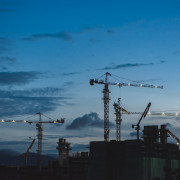The Advantages Of Bolts And Nuts Over Welds
Bolts And Nuts Vs. Welds
If you are designing heavy industrial infrastructure such as buildings and railroads, should you weld or bolt them in place?
On the surface, this might not seem like such a major decision to make, and there are many people who often choose their fastening methods in an arbitrary manner.
However, the truth of the matter is that there are many differences between the two methods of fastening, and you need to be careful about which one you end up picking. This is mainly due to the fact that there are certain times when using fasteners, such as Inconel hex lag bolts and nitronic 60 hex tap bolts, makes more sense than welding.
Consistent Bonds With Fasteners
Find the hardware solutions you're looking for here.
In some instances, it’s critical that the bonds you create during a manufacturing process be as consistent as possible. If, for instance, it turns out that there are some parts of a train track where the bonds are not as strong as in other areas, this could turn out to be the weak spot that results in damage to the entire track. As a result, you will have to spend a lot more time fixing this part of the track compared to the rest.
This is an issue that is usually very easy to solve when you use regular fasteners such as bolts and nuts. As long as you make sure that they are installed using the same torque and at an equal distance from each other, you can be assured that the weight will be distributed evenly among them.
Easier Inspection
When doing any major infrastructure installation such as construction of a bridge or a railway, you have to pay attention to the ease with which the tracks can be inspected. When you have a weld in place, it’s usually more difficult to do a visual inspection. You will often need to employ the use of more sophisticated equipment such as an x-ray machine to find out if there are cracks in the welds. This is not only cumbersome to use, but can also turn out to be a bit more expensive than you had bargained for.
Easier Replacement Of Parts
One of the most significant problems with using welds to put infrastructure together is the fact that it will make the whole installation more or less permanent. This means that if a section of the installation needs any replacement, you would need to take down the entire structure in order to do so. Using other means of repair can be very expensive.
However, when you do a modular installation and use bolts and nuts to fasten each module, you would only need to identify the one that has the problem, undo the fasteners, and replace it. In addition to being cheaper, this is also a much faster way of doing maintenance.
If you're in charge of designing such a facility, you should always give thought to the types of fasteners you would use. It will determine a lot regarding the future use of the structure.
About the Author

Started my career in the fastener world in 1969 at, Parker Kalon Corp. a NJ based screw manufacturer located in Clifton, NJ working in inventory control, scheduling secondary production and concluding there in purchasing. In 1971 I accepted a sales position at Star Stainless Screw Co., Totowa, NJ working in inside sales and later as an outside salesman, having a successful career at Star I had the desire with a friend to start our own fastener distribution company in 1980 named: Divspec, Kenilworth, NJ. This was a successful adventure but ended in 1985 with me starting Melfast in August 1985 and have stayed competitive and successful to date. Melfast serves the OEM market with approximately 400 accounts nationally.


